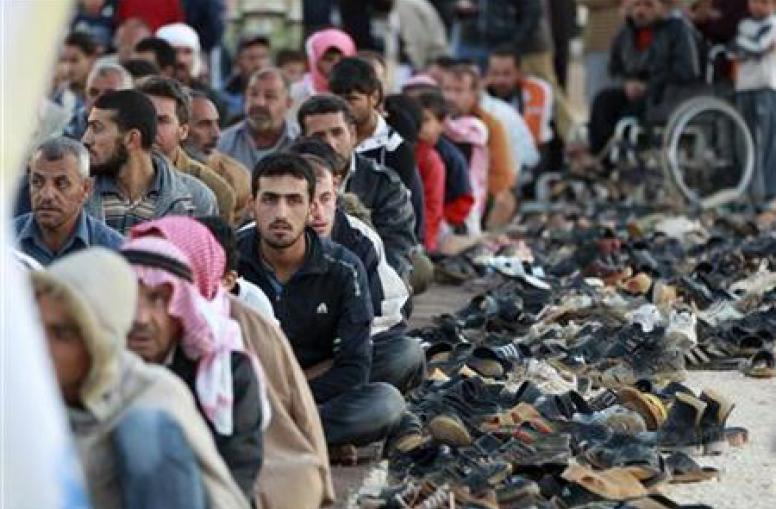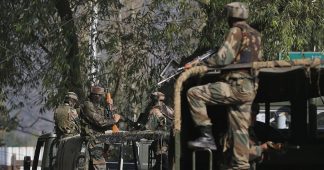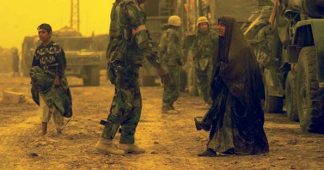By Joanne Laurier
The US drone assassination program epitomizes the criminality of the Barack Obama administration and the American military-intelligence machinery.
Launched under George W. Bush in 2002, drone warfare is part of the explosion of American militarism aimed at establishing US global hegemony. That drone strikes constitute war crimes under international law has not slowed their pace. Far from it. The British human rights organization, Reprieve, currently estimates the “US has used drones to execute without trial some 4,700 people––that we know of.”
The new documentary by Sonia Kennebeck, National Bird, takes on America’s use of lethal drones. The film’s title points to the fact that the drone, and not the bald eagle (chosen in the midst of the American Revolutionary War in 1782), should now be identified as the national emblem.
Produced by filmmakers Wim Wenders and Errol Morris, the movie brings to light the story of three whistleblowers who speak about their experiences in the drone program. The New York-based Kennebeck (born in Malaysia), also traveled to Afghanistan to interview civilian victims of US attacks.
The documentary presents a wealth of significant material. Its most serious limitation is the failure to challenge head-on the legitimacy of the “war on terror.” The latter is the justification for the US drone strikes that have killed thousands in Afghanistan, Iraq, Pakistan, Yemen and Somalia and terrorized far broader sections of the populations in those nations. All of this has been done behind the backs of the American people.
The production notes for National Bird explain that aerial combat drones “are the tip of the spear in a secret war waged remotely by thousands of service members, men and women, who are bound to silence. Many missions are highly classified, and the official tally of civilian (‘non-combatant’) deaths, first reported in July 2016, has been criticized by many NGOs as misleadingly low. But U.S. government officials, including President Obama, are adamant in their assurances that combat drones are precise and effective weapons that kill verified enemies and minimize military casualties, while preventing unnecessary civilian deaths.”

The notes continue: “Heavily armed Reaper or Predator drones fly miles above the ground and use their cameras to track human targets for days or even weeks, like invisible stalkers. This image is heavily promoted by the military. One U.S. Air Force recruitment commercial begins with what looks like a combat scene from a video game: U.S. soldiers march through a desert, anticipating an enemy attack. A military drone, operated by pilots in a control room somewhere in the U.S., is supporting the ground troops from the air, and targets hostile snipers. The slogan ‘It’s not science fiction,’ punctuates the scene.”
National Bird reveals that drone pilots and analysts are eyewitnesses to the fatal blows delivered by their strikes. They further observe the horror of the victims’ families as they collect the remains of their loved ones. As a result, many of the pilots themselves suffer acute psychological trauma, exacerbated by the fact that due to the secret nature of their work, they cannot discuss the details of these experiences, either with professionals or even with family members.
Kennebeck began her research three years ago by speaking to veterans’ organizations and activists. She subsequently familiarized herself with the drone program through declassified military and investigative reports on drone strikes. The three main human subjects in her film are Heather, Daniel and Lisa.
–Heather grew up in Pennsylvania and was recruited by the US Air Force at age 18 while attending community college. Stationed in the US, she worked with drones that flew over Afghanistan and Iraq, participating in her first mission when she was 20 years old.

–Daniel, from rural Tennessee, was a private contractor and former signals intelligence analyst. Unable to pay for his college tuition, he was homeless when he enlisted in the Air Force. He was deployed to Afghanistan, where he was assigned to the Joint Special Operations Command (JSOC) to track down targets for drone attacks.
–Lisa joined the military as an army medic and nurse. She was transferred to an intelligence squadron and eventually worked on a weapons system that found and killed targets. Each of the three had a top-secret clearance.
Also featured is Jesselyn Radack, an attorney in the US who has represented a number of the most prominent national security and intelligence community whistleblowers, including Edward Snowden.
Heather, Kennebeck’s film shows us, is a tormented soul. She can hardly get through an interview segment without unraveling emotionally. She suffers from post-traumatic stress disorder. She is in constant “pain and absolute despair.” An experience like no other, Heather explains, is watching “someone in their dying moments,” a nightmare for which she is responsible. “I don’t know how many people I’ve killed … the drone program is wrong,” she asserts, adding that “surgical strikes are not possible.” She was one of the first analysts to publicly criticize the use of drones.
Daniel joined the military “out of desperation.” He was “homeless—on my last legs.” In addition to his war trauma, Daniel faces prosecution under the Espionage Act for speaking out. He describes an FBI raid in which 30 to 50 agents broke into his apartment. Attorney Radack explains that since 1917, “only 12 people have been prosecuted under the Espionage Act. Daniel is in danger of becoming the 13th.”
The interview and other footage is interspersed with aerial cinematography meant to convey the presence of an omnipresent spying apparatus. Kennebeck comments in the film’s press notes that “we are turning the camera around to make our audience understand what it feels like to live under constant surveillance.”
What makes National Bird unusual is that it concerns itself not just with US imperialism’s American victims, but also its overseas victims. While the film contains many moving segments, the footage from Afghanistan is some of the most devastating.
To her considerable credit, Kennebeck chose to find and interview survivors of a February 2010 US drone strike in which 23 family members were killed. One woman weeps over the deaths of two children, four and six years old. Others are missing limbs. All have suffered horrific consequences from the bombing.
As the documentarian states in an interview: “We took our time with the Afghan protagonists to get to know them before we set up the main interviews. We wanted to be sensitive and also give them the same attention that we gave our U.S. protagonists, as much as it was possible in a warzone. The filming circumstances were difficult but my director of photography was incredibly respectful and his cinematography reflects that. When we spoke to the Afghan survivors it became immediately clear that they wanted to tell their stories and wanted their voices to be heard by the world community.”
The filmmaker also has actors portray the Predator crew as they prepared and launched the murderous February 2010 assault. The callous, heartless dialogue is taken from the actual transcript.
A deeply disturbing movie, National Bird, however, as noted above, has definite and identifiable limitations. It removes the drone program from the quarter century of almost perpetual war conducted by the US government, military and intelligence. It would seem reasonable to ask: why has the drone program, which has earned the hatred of tens of millions around the world, been implemented? What is the desperate, geopolitical purpose? Kennebeck’s film is silent on these larger issues.
In the film’s production notes, the director remarks that she wants to “enliven the public debate” and enrich “the existing discourse.” But what public debate is she referring to? What existing discourse? During the 2016 presidential campaign, there was not one word said about the drone program by the Democratic and Republican candidates. Hillary Clinton and Donald Trump fully agreed on the need to continue these bloody attacks.
Kennebeck therefore is reduced to clutching at straws. She turns, for example, to retired US Army general Stanley McChrystal for assistance. Her decision to present the latter in a positive light apparently stems from his investigation into the above-mentioned February 2010 drone bombing.
McChrystal occasionally postures as a “populist” and a maverick, but his hands are soaked with blood from his time as commander of US and international forces in Afghanistan. The retired general is now pushing for an obligatory year of “national service” for American youth, which would only be the prelude to the introduction of conscription. That would result in vast numbers of new Heathers, Daniels and Lisas. It is an indication of the current political vacuum that McChrystal could possibly be depicted as a human rights sympathizer.
That being said, National Bird is a remarkable film for its concentration on one of the principal deadly tools in the prosecution of America’s endless wars.











